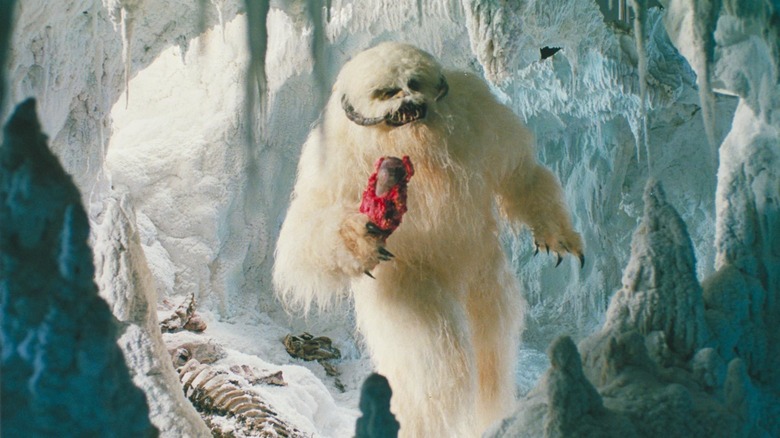How Star Wars Found Someone Willing To Suffer Through The Pain Of A Wampa Suit
Near the beginning of Irvin Kershner's 1980 sci-fi flick "The Empire Strikes Back," the psychic rebel warrior Luke Skywalker (Mark Hamill) is riding alone through the snowy drifts of the distant planet Hoth, mounted on the back of a bipedal beast of burden called a tauntaun. He is on the lookout for any sign of the Empire, hunting the rebels after the destruction of their superweapon, the Death Star. Rather suddenly, Luke is attacked by a wampa, a humanoid yeti native to the planet. The wampa kills the tauntaun, claws Luke, and drags the hapless rebel back to its lair, presumably to be eaten.
The wampa is only seen in flashes. Luke sees a roaring face for a split second and a waving claw. For the 1997 Special Edition of "The Empire Strikes Back" — a notorious re-release that remastered and reworked most of the effects shots — a full-bodied shot of the wampa was included. It was seen hiding in its cave, chewing on bones, feasting on an appetizer before eating Luke Skywalker. Although most of the new effects created for the Special Edition "Star Wars" films were achieved through CGI, the new wampa footage was achieved with a brand new high-tech suit, worn by special effects artist Howie Weed.
Weed had been working in the industry since 1984 as a part of the creature team for Joe Dante's "Gremlins." He would go on to create monsters for movies like "House," "The Fly," "RoboCop 2," "The Blob," "Naked Lunch," "Star Trek VI: The Undiscovered Country," and "Dragonheart." In the Special Edition of the original "Star Wars," Weed also appeared on screen as a character named Ketwol, an elephant creature.
In issue #33 of Star Wars Insider Magazine, Weed went on record with his enthusiasm for playing the wampa.
'I volunteered right off the bat!'
Weed recalls working on the movie, and initially catching wind that the creature department still needed a suit actor for the massive yeti.
"I volunteered right off the bat! [...] I was one of the five or six people who had been consistently doing creature type work in the model shop. It just so happened that I got connected on this show as the construction supervisor and so I ended up going to the meetings and talking with the art department. When I saw the storyboards and found out what we were doing, I knew I really wanted to do this just because I'd been doing creature work for approximately 14 years."
Having made so many creatures and suits in the past, Weed knew exactly what was required of an actor, as well as how heavy the suit was going to be. He still volunteered, but it was going to be a rough day's work. He continued:
"[B]eing the monster in the suit is the ultimate, but I knew it was going to be a really uncomfortable, really hot, and, in a way, a really horrible thing to put yourself through."
The task then began to envision a wampa in its final form. In the original cut of "Empire Strikes Back," audiences only saw pieces of it. This was going to be the first visible, canonical appearance of a wampa, and Weed had to figure out what kind of animal it was, how it moved, and what its dimensions were. Remaining true to what a viewer might expect, the wampa was a humanoid yeti. Weed says he drew the look and movement from old Ray Harryhausen-conceived creatures from fantasy favorites like "Clash of the Titans" (1981) and "Jason and the Argonauts" (1963).
O.W. Original Wampa
The plans for the original wampa suit, constructed in pieces in 1979, were far more ambitious than what audiences saw. A full-sized suit made of sheepskin was constructed for suit actor Des Webb, and it required a ladder to climb into. Webb hand to stand up on rickety stilts, and was required to grab actor Mark Hamill and drag him into the wampa lair. The problem was that walking through fake snow on stilts, covered in a hundred pounds of sheepskin is no easy task, and Webb kept falling over. It seems that Weed, even in the improved suit, had a similar issue.
Weed knew all about Webb's original wampa performance, and that it ultimately had to be abandoned. Weed said:
"If you've ever tried to drag a real human being behind yourself without stilts on down a smooth hallway, it's really impossible ... I felt so sorry for the guy because he was trying so hard, but there was just no way, given his proportion and what they were asking him to do, that it was going to work. It looks like they spent maybe a day trying to get that concept on film, when they finally gave up."
The final wampa looks amazing, though, and might have been one of the last practical "Star Wars" creatures to grace the screen for many years; George Lucas notoriously turned to mostly CGI for his "Star Wars" prequel films made between 1999 and 2005. Weed continued to work as a digital modeler on those films as well. Most recently, Weed worked as a digital artist for blockbusters like "Avengers: Infinity War" and "Black Panther: Wakanda Forever." He does good work, that guy.
